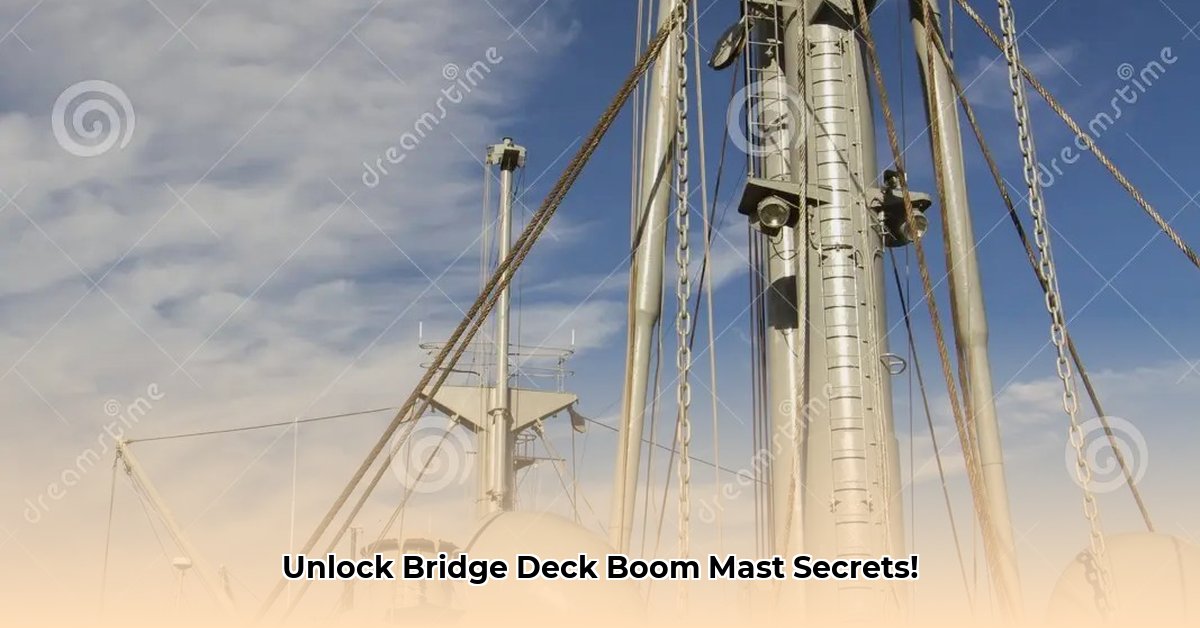
Bridge Deck Boom Mast: An Introduction
The bridge deck boom mast, a crucial piece of equipment on many vessels, is essentially a shipboard crane. It projects from the ship's superstructure, enabling the efficient loading and unloading of cargo, deployment of equipment, and other operations. Understanding its components and function is key to deciphering nautical terminology, often encountered in technical manuals and even crossword puzzles. This guide provides a comprehensive overview of this important maritime tool.
Technical Description of the Bridge Deck Boom Mast
The bridge deck boom mast is a complex system, comprising several key elements:
- The Boom: This is the long, horizontal arm extending from the mast, often made from high-strength steel or aluminium alloys, designed to withstand considerable stress and corrosion. (The main horizontal structural member of the crane).
- The Mast: A sturdy, vertical support structure, usually tubular, which provides the pivot point for the boom's movement. (The vertical support for the boom).
- Hydraulic System: This sophisticated system of cylinders, valves, and pumps provides the power for the boom's movement, allowing for precise positioning and control of the lifted load. (The power source and control mechanism).
- Hoisting Mechanism: This system includes winches, cables, and sheaves (pulleys), used to lift and lower cargo attached to the boom's end. Different systems, such as derricks or jib cranes, may be employed. (The system responsible for lifting and lowering cargo).
- Control System: Operators use this system (often a combination of joysticks, digital displays and automated systems) to precisely position the boom and control the hoisting system. (How the mast is operated).
Types of Bridge Deck Boom Masts
Several boom mast designs exist, tailored to specific vessel types and operational requirements:
- Knuckle Boom: Offers exceptional flexibility, allowing the boom to be positioned at various angles. (Excellent for versatile lifting tasks). However, it can be less stable than a straight boom.
- Straight Boom: A robust design offering superior stability, particularly suitable for heavier loads. (Simple, strong, and reliable). Its reach is, however, less versatile.
- Telescopic Boom: Allows for variable reach by extending or retracting sections of the boom. (Efficient use of space). This design does, however, introduce more complex mechanisms and potential maintenance issues.
The selection of boom type depends heavily on the vessel's function and the typical loads it will handle.
Operational Principles
The operational principles are relatively straightforward: hydraulic pressure actuates the cylinders to move the boom, while separate mechanisms control the hoisting system. Precise control is paramount for safety and efficiency, ensuring that the load is accurately positioned and moved without risk. Operating a bridge deck boom mast requires skilled operators who undergo specific training to ensure safe practices.
Safety Considerations
Safety is paramount when operating bridge deck boom masts. Regular inspections and maintenance are critical to identify and rectify any potential problems before they can cause accidents. Operators undergo rigorous training to understand the various safety mechanisms such as load limiters, emergency brakes, and overload protection systems. Clear communication protocols between the operator and the deck crew are also crucial.
Historical Context
The evolution of bridge deck boom masts reflects advances in materials science and engineering. Early designs were simpler, often employing manual winches and ropes. The introduction of hydraulic systems marked a significant leap forward. The development of stronger, lighter materials, such as high-tensile steel alloys, further enhanced their capabilities. The adoption of more sophisticated control systems, including digital and automated systems, reflects ongoing technological advancements in the maritime sector.
Contemporary Usage
Bridge deck boom masts are used across a wide range of vessels, including:
- Cargo ships (loading and unloading containers and bulk goods)
- Supply vessels (transferring supplies to offshore platforms)
- Research vessels (deploying scientific equipment)
- Rescue vessels (assisting with rescue operations).
Their adaptability and importance remain key factors for modern maritime operations.
Conclusion
The bridge deck boom mast, while seemingly a simple piece of equipment, embodies a blend of sophisticated engineering and practical maritime functionality. Its continued development and integration into modern shipping practices underline its importance to the industry. Ongoing advancements in materials, hydraulic systems, and control mechanisms will likely further enhance its capabilities and safety features in the years to come. A thorough understanding of its components, operation, and historical context is crucial for both maritime professionals and anyone seeking to enhance their understanding of nautical terminology.